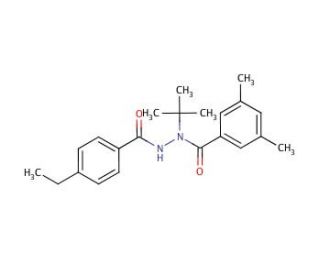

Tebufenozide (CAS 112410-23-8)
QUICK LINKS
Tebufenozide is a compound that has garnered interest in agricultural research due to its activity as an insect growth regulator. It is used in studies targeting the control of pest populations, particularly those of the Lepidoptera order. The compound′s mode of action involves mimicking the activity of naturally occurring hormones in insects, disrupting their normal molting process. In ecological research, Tebufenozide is utilized to understand the impact of such regulators on insect lifecycles and their potential effects on non-target organisms within the ecosystem. Additionally, it is used in investigations concerning the development of pest resistance, informing strategies for the sustainable use of growth regulators in integrated pest management programs. Researchers also study the environmental fate of Tebufenozide, including its degradation and persistence in soils and its potential for bioaccumulation.
Tebufenozide (CAS 112410-23-8) References
- Tebufenozide disrupts ovarian development and function in silkmoths. | Sridhara, S. and Lee, VH. 2013. Insect Biochem Mol Biol. 43: 1087-99. PMID: 24121094
- Tebufenozide resistance is associated with sex-linked inheritance in Plutella xylostella. | Cao, GC. and Han, ZJ. 2015. Insect Sci. 22: 235-42. PMID: 25813528
- Cytotoxic effects of tebufenozide in vitro bioassays. | Yu, X., et al. 2016. Ecotoxicol Environ Saf. 129: 180-8. PMID: 27043174
- Dissipation and metabolism of tebufenozide in cabbage and soil under open field conditions in South China. | Liu, J., et al. 2016. Ecotoxicol Environ Saf. 134P1: 204-212. PMID: 27636325
- An investigation into the formation of tebufenozide's toxic aromatic amine metabolites in human in vitro hepatic microsomes. | Abass, KM. 2016. Pestic Biochem Physiol. 133: 73-78. PMID: 27742364
- Tebufenozide induces G1/S cell cycle arrest and apoptosis in human cells. | Xu, W., et al. 2017. Environ Toxicol Pharmacol. 49: 89-96. PMID: 27960113
- Residue analysis and dietary exposure risk assessment of tebufenozide in stem lettuce (Lactuca sativa L. var. angustana Irish). | Lin, H., et al. 2018. Food Chem Toxicol. 120: 64-70. PMID: 29958988
- Toxicological and morphological effects of tebufenozide on Anticarsia gemmatalis (Lepidoptera: Noctuidae) larvae. | Fiaz, M., et al. 2018. Chemosphere. 212: 337-345. PMID: 30145425
- Genome-wide Identification of Tebufenozide Resistant Genes in the smaller tea tortrix, Adoxophyes honmai (Lepidoptera: Tortricidae). | Uchibori-Asano, M., et al. 2019. Sci Rep. 9: 4203. PMID: 30862839
- Determination, residue analysis, risk assessment and processing factors of tebufenozide in okra fruits under field conditions. | Luo, X., et al. 2020. J Sci Food Agric. 100: 1230-1237. PMID: 31696522
- The comparative metabolic response of Bactrocera dorsalis larvae to azadirachtin, pyriproxyfen and tebufenozide. | Zhou, Y., et al. 2020. Ecotoxicol Environ Saf. 189: 110020. PMID: 31809954
- Effects of Topical Tebufenozide Application to Choristoneura fumiferana Pupae (Lepidoptera: Tortricidae). | Roscoe, LE., et al. 2020. Insects. 11: PMID: 32183308
- Tebufenozide has limited direct effects on simulated aquatic communities. | Edge, C., et al. 2022. Ecotoxicology. 31: 1231-1240. PMID: 36083423
Ordering Information
| Product Name | Catalog # | UNIT | Price | Qty | FAVORITES | |
Tebufenozide, 100 mg | sc-280110 | 100 mg | $200.00 |
